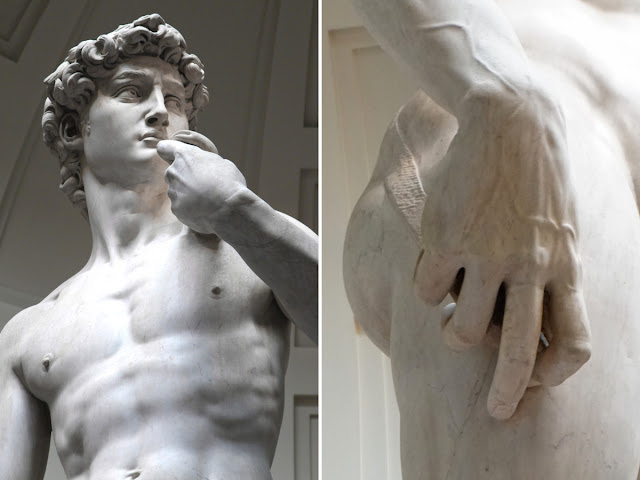These are my personal notes and observations on art of
Michelangelo the way I see it. (reading the book of Jilles Neret about
Michelangelo).
Michelangelo was a great artist, sculpture and painter of
frescoes in time of Italian Renaissance, born on 6. March (1475), Florence
His main theme in all art works was –the movement, passion,
expression of emotion in naked body; remains of archetypal pagan energy is felt
in most of his works, together with great masculine force. He was admirer of
male appearance, beauty and energy of male naked body, that was obviously
constant object of his work. Female body was depicted by him in paintings,
frescoes and sculptures with rude masculine outlines, big stable hands, neck
and muscles, and somehow strange breasts attached to the torso. All the females
resemble male outlook.
The basic feelings expressed in his art are: passion, movement, fight
between passion and mind in human, weakness and strength in human naked body, muscles
tension, body and soul suffering, the torment of the soul, impetuosity, hidden
and expressed emotions in human, catharsis of soul, punishment of physical body
in Apocalypse, purification of the soul trough suffer, image of the real
rebellion of physical body on earth trough rage of emotions. All of these
expressions of his art give the passionate music of Michelangelo sculptures.
My favorite art works by Michelangelo ~
(1) David sculpture, (2) Pieta (Sculpture group), (3) Moses
(sculpture appointed for the tomb of Papa Julius II, (4) The dying Slave
(sculpture)
Paintings: Torment of St. Anthony, Scenes of Last Judgment
(Self-portrait bitten by demon-snake) from Fresco groups.
The Torment of St. Anthony (1487)
Some time frame of his works:
1487 - The Torment of
St. Anthon
1492 - Crucifixion (with
naked Jesus)
1495 - Angel with Candle
stick (winged angel sculpture)
1499 - Pieta (sculpture
group with Virgin Mary and Jesus)
1501 - The Entombment
(painting unfinished)
1501 – 1504 David
(sculpture)
1506 - Tondo Donni (Holy
Family with St. John
1509 - Ignudo – detail
of man naked male from Cappella Sistina
1509 – 1512 – Ceiling of Cappella Sistina (Vatican city
1512 - Adam and Eve
(scene from Cappella Sistina fresco)
1513 -1515 – Moses (impressive sculpture for tomb of Papa
Julius)
1505 – 1513 Rebellious
slave (sculpture for the tomb)
1513 – 1515 The Dying
Slave (sculpture with male exalted body)
1520 - Leda and the Swan
(popular theme, painting)
1530 - Apollo (sculpture
of loved Greek mythology god)
1531 - Medici Madonna
(sculpture of Madonna and child)
1533 – The dream of human life (drawing)
1534 - Cleopatra (drawing
portrait with snake)
1526 – 1533 Tomb of Medicci (the project was postpone and
changed)
1545 - Rachel and Leah
(two sculptures)
1550 - Pieta (Madonna,
Jesus and self-portrait sculpture of an old man)
Michelangelo work and style were influenced by: Greek sculpture
of Antiquity, Giotto, Masaccio.
The Dying Slave (1515), beautiful movement of marble extasy
David (1501-1504) 517 cm tall
The sculpture is situated in Galleria del`Accademia, Florence. David is one of most renowned Renaissance pieces in the world, the balance of composition, posture and internal movement is in harmony with sparkling vitality of the marbel body. We have the feeling that he will move.
Pieta (1499) Sculture group in St. Peter`s basicllica (Vatican)
Moses, sculpture in Basilica di San Pietro (Vincoli) 1515
© Nina Nour








Comments
Post a Comment